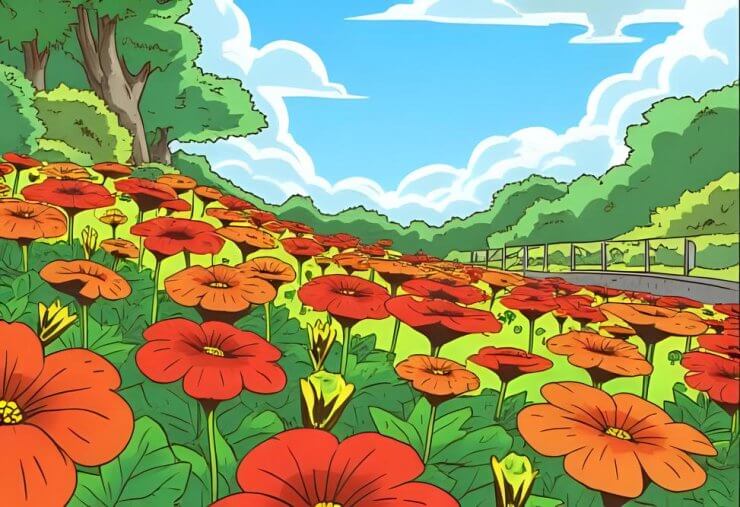
Nasturtiums (Tropaeolum) are cheerful, easy-to-grow annuals celebrated for their bright blooms, peppery leaves, and delightful trailing or mounding habits. With their jewel-toned flowers in shades of orange, red, and yellow, as well as cream, nasturtiums are a favorite in both ornamental and edible gardens. Their ability to thrive in less-than-perfect soils and bloom prolifically makes them a go-to choice for beginner gardeners and experienced horticulturists alike.
Beyond their beauty and taste, nasturtiums also provide excellent support to pollinators. Their funnel-shaped flowers are especially attractive to long-tongued visitors like bumblebees and butterflies, and they’re often visited by hummingbirds in areas where these birds are active.
Soil (pH) Requirements
Nasturtiums actually prefer lean, well-drained soil and don’t require heavy feeding or amendments. Rich soils can lead to excessive leaf growth and fewer flowers.
Ideal Soil Conditions
- pH range: 6.0 to 7.5
- Avoid overly fertile or heavily amended soil.
- Sandy or slightly rocky soils are ideal, as long as drainage is good.
If growing in containers, use a standard potting mix with good drainage and skip the fertilizer.
Sun Requirements
Nasturtiums are sun worshipers! They perform best in full sun, which means at least six hours of direct sunlight daily. However, in very hot climates, some light afternoon shade can prevent wilting and sun scorch.
Best Spots
- Sunny borders and edging
- Hanging baskets and window boxes
- Slopes or raised beds where vines can trail
Watering Requirements
Nasturtiums like consistent moisture, especially during early growth and flower production. That said, they are somewhat drought-tolerant once established.
Watering Tips
- Water deeply once or twice a week depending on weather.
- Let the top inch of soil dry out between waterings to avoid root rot.
- In containers, monitor daily—soil dries faster in pots.
Overwatering can lead to leggy growth and fewer blooms, so it’s all about balance.
Best Plant Hardiness Zones
Nasturtiums are annuals in most of the U.S., but they can behave like short-lived perennials in frost-free climates.
USDA Zones
Grown as annuals in Zones 2–11
In Zones 9–11, they may reseed and return the following year.
Sow directly after the last frost; they dislike transplanting due to fragile roots.
Nasturtiums’ Popularity and Pollinator Appeal
Nasturtiums are popular for their multi-use magic:
- Companion planting to deter pests and improve pollination
- Gorgeous ornamental color
- Edible leaves, flowers, and seeds
- Useful trap crop in vegetable gardens to draw aphids away from other plants
They are also fantastic for supporting pollinators, especially:
- Bumblebees, which love the deep flower throats
- Honeybees, particularly for single-flower varieties
- Hoverflies, which visit open blooms and control aphid populations
- Butterflies, especially skippers and small brush-foots
- Hummingbirds, who find the nectar-rich flowers irresistible
Five Vibrant Nasturtium Varieties and Their Uses
Alaska Mix
A standout variety for its variegated foliage, Alaska Mix features green-and-white marbled leaves paired with bright yellow, orange, and red blooms. Its bushy habit makes it a great choice for edging and containers.
Popular Uses
- Ornamental container displays
- Edible flowers for salads and platters
- Foliage interest in mixed borders
Pollinator Note: The open, vivid flowers draw hoverflies and honeybees, especially when planted near herbs and veggies.
Best Zones: 2–11 (annual)
Jewel Mix
Compact and vibrant, Jewel Mix is a classic mounding nasturtium that produces semi-double blooms in bold red, yellow, and orange tones. It’s one of the most prolific flowerers, even in poor soil.
Popular Uses
- Edging flower beds or walkways
- Container gardens and hanging baskets
- Colorful garnishes for culinary dishes
Pollinator Note: This variety’s profusion of blooms is a magnet for bumblebees, providing easy access and extended nectar availability.
Best Zones: 2–11
Empress of India
Known for its deep crimson blooms and dark blue-green foliage, Empress of India adds a regal touch to the garden. The compact, bushy growth makes it ideal for tighter spaces or contrasting color schemes.
Popular Uses
- Heritage-style flower beds
- Dark foliage contrast in mixed plantings
- Edible red flowers for striking culinary presentations
Pollinator Note: Its intense color and rich nectar attract hummingbirds and native bees, particularly in mid to late Summer.
Best Zones: 2–11
Trailing Nasturtium
This classic climbing or trailing nasturtium spreads vigorously, making it ideal for covering fences, tumbling over walls, or sprawling through cottage gardens. Blooms come in all classic colors and produce prolifically.
Popular Uses
- Living mulch or ground cover
- Vertical garden feature or trellis accent
- Cut flower garlands and edible décor
Pollinator Note: The long spurs of trailing varieties are especially favored by hummingbirds and long-tongued bumblebees.
Best Zones: 3–11
Tip Top Apricot
Tip Top Apricot offers a more subtle palette with soft pastel-orange blooms and tidy, compact growth. It’s bred for consistent flowering above the foliage, creating a well-rounded display.
Popular Uses
- Soft-toned garden designs
- Accent plant in herb or butterfly beds
- Petite flower beds or raised planters
Pollinator Note: The pastel hues still appeal to hoverflies and small solitary bees, especially when grouped for visual impact.
Best Zones: 3–10


 Previous
Previous

